Rudely ignoring mankind’s widespread refusal to accept its truth, climate change has already begun reshaping our world: melting the ice caps, acidifying the sea, and stirring up wild weather. The recent IPCC report couldn’t be clearer: Our time with the Earth as we know it is limited, now. In fact, within the next generation or two, popular tourist destinations ranging from seashores to mountaintops to major world cities will begin to decline, and absent a level of global policy change or technological innovation that seems unthinkable, some will surely be radically altered or lost. So if you’ve been putting off that snorkeling trip to the Great Barrier Reef or that ski adventure to the Alps, time to get booking—the geological clock is ticking.
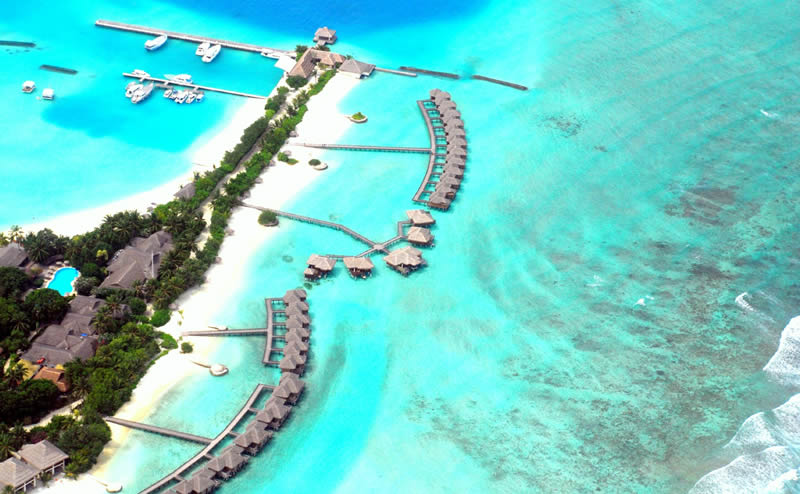 Islands don’t float; they are the tips of mountain ranges on the sea floor. They’re the canaries in the climate change coal mine: the first places to be directly, catastrophically threatened by rising sea levels.
Islands don’t float; they are the tips of mountain ranges on the sea floor. They’re the canaries in the climate change coal mine: the first places to be directly, catastrophically threatened by rising sea levels.
The denizens of The Maldives, Kiribati, and other island nations, have resigned themselves to becoming among the first climate change refugees. In 2009, the first of the 2,600 residents of the Carteret Islands, off the coast of Papua New Guinea, were evacuated; thsee coral atolls are expected to be completely underwater by 2015. Even rich islands buoyed by tourism dollars can’t buy their way out of this fate; the Maldives, for example, have begun an investment fund to raise money for relocation.
And that slow drowning is, incredibly, a best-case scenario. Long before the waves close over islands like Carteret, Kiribati, and Tuvalu, the ocean waters will infiltrate, ruin crops, and destroy their residents’ sources of fresh water. And if a violent storm strikes—something on the scale of Typhoon Haiyan, which devastated the Philippines last year—the fatal blow could arrive much sooner.
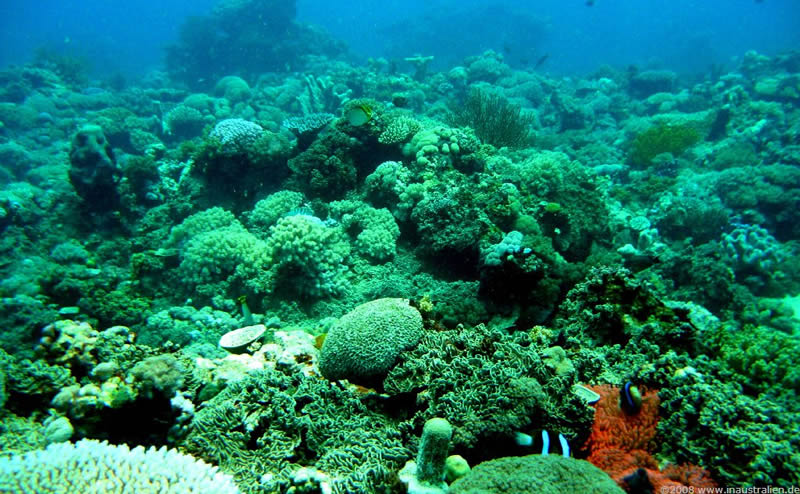 The Great Barrier Reef is a fifteen hundred-mile-long piece of living architecture that supports vast numbers of marine organisms by providing food and protection. The reef is also dying, and dying quickly. In 2012, scientists estimated that the Great Barrier Reef had already lost more than half of its coral cover since 1985. The cause is not rising sea levels, but another insidious side effect of climate change: ocean acidification.
The Great Barrier Reef is a fifteen hundred-mile-long piece of living architecture that supports vast numbers of marine organisms by providing food and protection. The reef is also dying, and dying quickly. In 2012, scientists estimated that the Great Barrier Reef had already lost more than half of its coral cover since 1985. The cause is not rising sea levels, but another insidious side effect of climate change: ocean acidification.
Reefs are as fragile as they are beautiful, and are threatened by a variety of human activities ranging from overfishing, agricultural runoff and siltation from deforestation, population increases of coral-eating species like the Crown of Thorns starfish and invasive species like the native-species-gobbling lionfish. But ocean acidification and ocean warming promise to be the final two nails in the coffin.
Greenhouse gases like carbon dioxide don’t just stay in the atmosphere; our oceans absorb what they can. And they have absorbed around 150 billion metric tons of human-generated CO2…about a third of what we’ve produced since we discovered fire. Carbon dioxide reacts with water in a chemical process that releases protons (really the ion H+, a bare hydrogen nucleus with no electrons) and lowers the pH of the sea, making it more acidic. This increasing acidity of the ocean also lowers its “aragonite saturation state”—the concentration of calcium and carbonate ions in the water—making it more difficult for coral to build its calcium carbonate coating.
Warming ocean temperatures make the acidification situation even worse. A coral reef is made up of animals called polyps, which serve as hosts for microscopic plants called zooxanthellae. When ocean temperatures rise, the coral gets stressed out and expels the zooxanthellae. Zooxanthellae give a reef its brilliant colors, so when the polyps reject them, the coral turns white; this is called “bleaching.” Bleached colonies stop growing and sometimes die. Major bleaching events have occurred over the years—there were significant ones on Great Barrier Reef in 1998 and 2002—and they’re expected to increase in frequency and intensity as global temperatures rise.
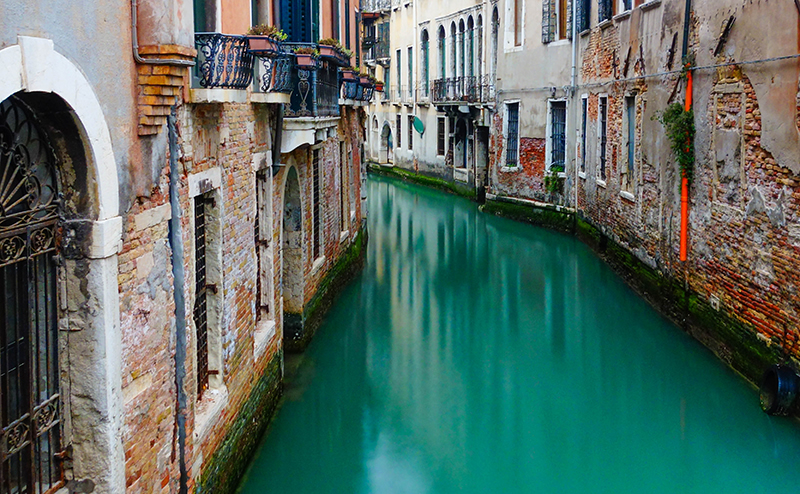 Venice, “The City of Water,” is gradually being reclaimed by its famous canals. The city, built upon 118 small islands in the middle of a lagoon, is sinking by 1 to 4 millimeters per year, and the waters around it are rising at a similar rate, a one-two punch leading to increasingly worse flooding—at times today as much of 70% of the city is underwater. And the problem will only worsen as the sea level continues to rise.
Venice, “The City of Water,” is gradually being reclaimed by its famous canals. The city, built upon 118 small islands in the middle of a lagoon, is sinking by 1 to 4 millimeters per year, and the waters around it are rising at a similar rate, a one-two punch leading to increasingly worse flooding—at times today as much of 70% of the city is underwater. And the problem will only worsen as the sea level continues to rise.
The government has spent years (and billions of euros) constructing a complex system of dams to protect the city from the sea, a system nicknamed Moses after the project’s Italian acronym, MOSE. Can this Moses part the sea as well as its Biblical counterpart? Possibly, but many Italians fear the project will cost too much money and arrive too late. And if it does work, due to the continually rising sea level the floodgates will have to be closed increasingly often and for longer stretches, upsetting the natural exchange of water between the sea and the lagoon, and threatening to suffocate its delicate ecosystem.
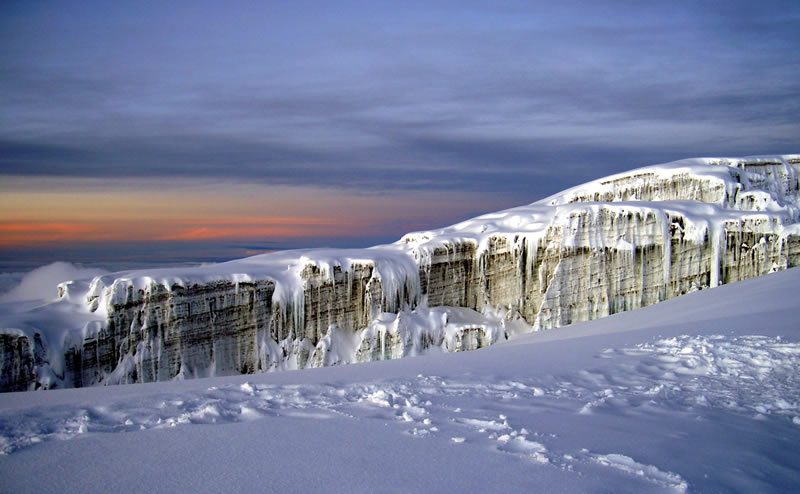 Ernest Hemingway’s short story “The Snows of Kilimanjaro” is starting to sound downright nostalgic. A 2009 study published in the Proceedings of the National Academy of Sciences found that 90% of the ice on the peak of Africa’s highest mountain (19,341 feet above sea level) has simply disappeared since 1912. The scientists determined ice coverage losses by looking at aerial photographs and historical ice maps, and by drilling ice cores to test the thickness of the remaining ice. While Kilimanjaro’s ice loss predates human-caused climate change, the rate at which the mountain’s ice coverage has been shrinking has doubled since the 1970s. If this trend continues, the snows of Kilimanjaro will be gone in twenty years.
Ernest Hemingway’s short story “The Snows of Kilimanjaro” is starting to sound downright nostalgic. A 2009 study published in the Proceedings of the National Academy of Sciences found that 90% of the ice on the peak of Africa’s highest mountain (19,341 feet above sea level) has simply disappeared since 1912. The scientists determined ice coverage losses by looking at aerial photographs and historical ice maps, and by drilling ice cores to test the thickness of the remaining ice. While Kilimanjaro’s ice loss predates human-caused climate change, the rate at which the mountain’s ice coverage has been shrinking has doubled since the 1970s. If this trend continues, the snows of Kilimanjaro will be gone in twenty years.
Curiously, the ice on Kilimanjaro is not melting at all; in fact, the air at the summit always stays below freezing. But sunlight there excites water molecules into sublimation, the process by which a solid (here, ice) is transformed into a gas without ever become a liquid (here, water), skipping the melting step altogether. Scientists are still working to fully explain the connection between human-driven climate change and the loss of snow. Increased dryness—which also causes droughts and famine across many East African countries—is thought to be a primary contributor to the long term problem, as there has been less snow precipitating to replenish ice loss.
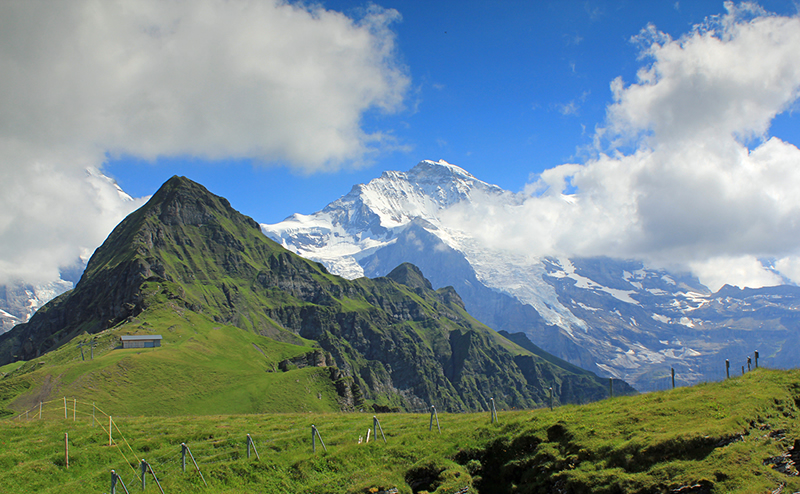 Chamonix-Mont-Blanc, home of the first winter Olympics, will find it hard to host another one in the foreseeable future. The Alps are warming at double the rate of the rest of the world, and it’s already causing problems for the tourist industry that supports Alpine mountain towns.
Chamonix-Mont-Blanc, home of the first winter Olympics, will find it hard to host another one in the foreseeable future. The Alps are warming at double the rate of the rest of the world, and it’s already causing problems for the tourist industry that supports Alpine mountain towns.
Since the late 19th century, temperatures have risen by over one degree Celsius. It doesn’t sound like much, but there’s an outsize effect on snowfall: In the last fifty years, the Alps’ lower-lying resorts have seen about 40% less snow. In the last twenty years, the Mer de Glace (“sea of ice”) glacier, not far from Chamonix, has lost over 210 feet in depth. Subtract another degree or two of temperature change, and it’s easy to imagine the snow-capped Alps becoming nothing but a postcard memory.
Ski towns in the Alps are already trying to adapt, increasing spa offerings, conference centers, and luxury hotels they hope will keep drawing tourists and businesspeople to the area, after the snow is gone.
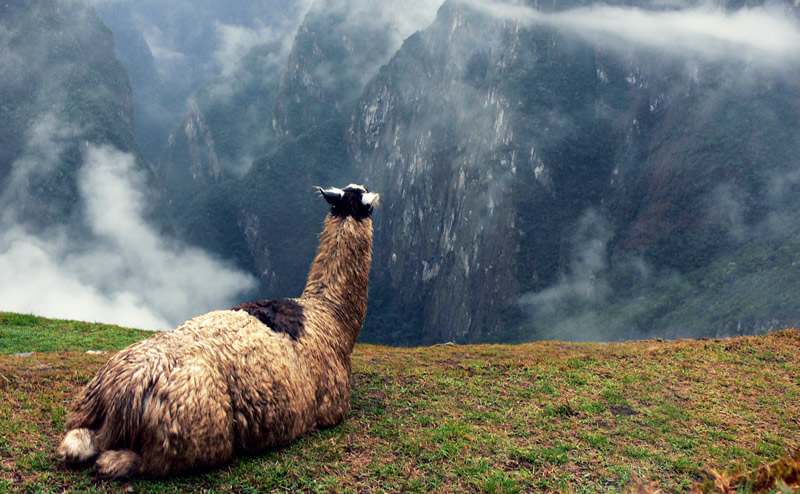 The thin, longitudinal Andes mountain range, separating the South American jungle from the sea, is a wondrously biodiverse habitat. Even the most minute change in the level of elevation produce a radical shift in the local fauna and flora. But the precise ecological adaptation underlying the Andes’ diverse beauty is also a weak spot, and even gradual climate change has been quietly wreaking havoc.
The thin, longitudinal Andes mountain range, separating the South American jungle from the sea, is a wondrously biodiverse habitat. Even the most minute change in the level of elevation produce a radical shift in the local fauna and flora. But the precise ecological adaptation underlying the Andes’ diverse beauty is also a weak spot, and even gradual climate change has been quietly wreaking havoc.
As temperatures rise, locally adapted life in the Andes has had to go on the move to find more hospitable terrain, as New Yorker staff writer Elizabeth Kolbert documents in The Sixth Extinction. It’s not just animals: Global warming is driving trees up the mountains, as higher-ground seedlings survive and lower ones don’t, generation after generation, at an average speed of about eight feet per year, according to a team of researchers led by Wake Forest scientist Miles Silman. A few are well adapted for this forced migration: The Schefflera genus of tree is sprinting at a rate of almost a hundred feet per year. But many cannot, and go extinct.
Migration, particularly in the case of rooted trees, is an impressive response to global warming, but not a failsafe one. As plant and animals move up a conical mountain, geometry dictates they have less terrain on which to live; once you’re at the top, the game is over. For thousands of species, specifically adapted to locations all along the range, it’s difficult to estimate what the full impact of climate change will be over time. Some projections say that even under minimal warming expectations, 9% of species in the Andes could be near extinction by 2050.
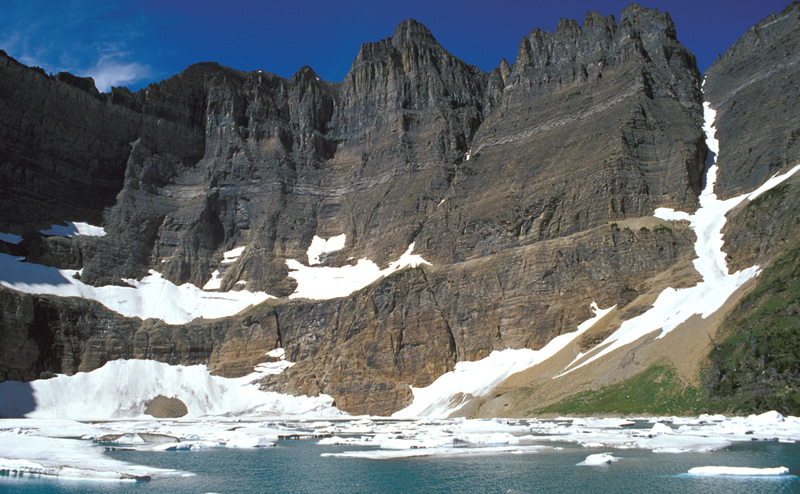 Montana’s Glacier National Park is known for great hiking, an abundance of wildlife, and spectacular views—particularly of the glaciers for which it was named. But the glaciers are in full retreat. According to studies by the U.S. Geological Survey, of the roughly 150 glaciers present when the park was founded in 1910, there are only around 25 left that are larger than 25 acres. Models predict that the largest glaciers will all be gone by 2030.
Montana’s Glacier National Park is known for great hiking, an abundance of wildlife, and spectacular views—particularly of the glaciers for which it was named. But the glaciers are in full retreat. According to studies by the U.S. Geological Survey, of the roughly 150 glaciers present when the park was founded in 1910, there are only around 25 left that are larger than 25 acres. Models predict that the largest glaciers will all be gone by 2030.
As the glaciers disappear, they are irrevocably changing the park’s ecosystem. Glaciers function as water storage: Their melting helps regulate the temperatures of streams and maintain the flow of water during late summer and drought periods. Without glacial melt water to cool it, summer water temperatures will increase, potentially killing off sensitive aquatic species, leading to disruptions further up the food chain—threatening the survival of all the park’s wildlife, including wolves, mountain goats and grizzly bears.
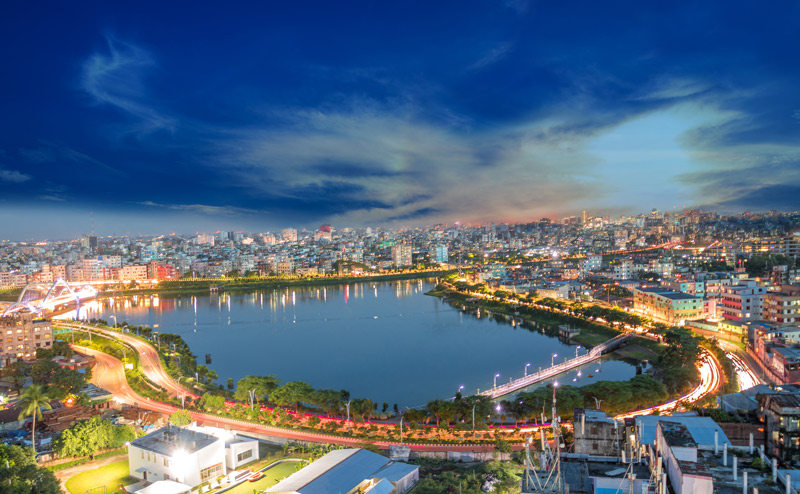 Bangladesh is one of most densely populated nations in the world: It’s roughly the size of New York State, but is home to about eight times the population. It’s Asia’s New Orleans, in a manner of speaking, draining the Himalayas, highest mountains in the world, to the sea. The Ganges, the river delta on which this flat, low-lying country sits, is made up of 230 rivers and streams, many of which already consistently flood every year, devastating huge communities of some of the world’s poorest citizens.
Bangladesh is one of most densely populated nations in the world: It’s roughly the size of New York State, but is home to about eight times the population. It’s Asia’s New Orleans, in a manner of speaking, draining the Himalayas, highest mountains in the world, to the sea. The Ganges, the river delta on which this flat, low-lying country sits, is made up of 230 rivers and streams, many of which already consistently flood every year, devastating huge communities of some of the world’s poorest citizens.
Now, research indicates that high tides in Bangladesh are rising ten times faster than the global average. Already, salt water increasingly intrudes into rivers, leaving the water brackish and ruining desperately needed cropland. By 2050, seawater will flood roughly 17% of the land, completely displacing about 18 million people.
It gets worse: Because its rivers are so polluted, Bangladesh relies almost entirely on groundwater for drinking. Pumping this water out has the effect of deflating the land—the country is literally sinking as the waters rise. Unfortunately, Bangladesh has little altitude to absorb this change, as fully a fourth of the country is seven feet above sea level or less.
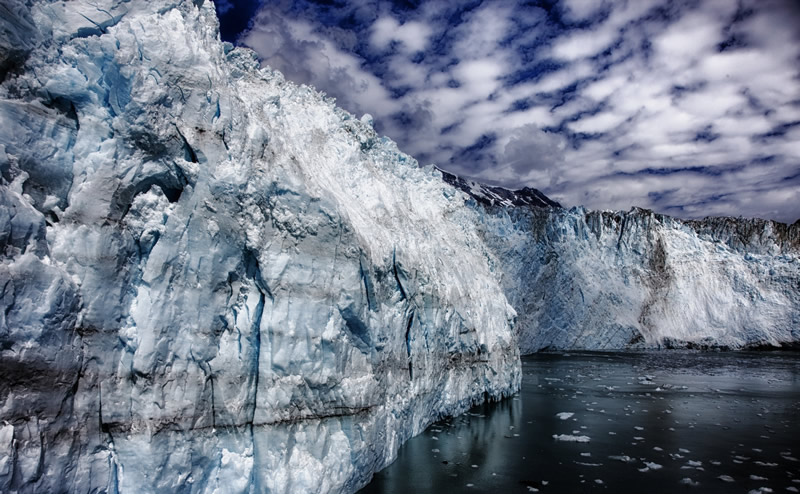 All the world is warming, but not at the same rate. The Arctic is warming twice as fast as the rest of the planet, and as a result the area of Arctic land covered by snow in early summer has shrunk by almost 20% since 1966. Climate models predict that the Arctic Ocean could be ice-free by the end of the century.
All the world is warming, but not at the same rate. The Arctic is warming twice as fast as the rest of the planet, and as a result the area of Arctic land covered by snow in early summer has shrunk by almost 20% since 1966. Climate models predict that the Arctic Ocean could be ice-free by the end of the century.
Why? The main reason for the Arctic’s disproportionately fast melting is something called the albedo effect. Albedo, the degree that light radiation is reflected by a surface, is the reason why no one likes to wear a black t-shirt at the beach in the summer—a darker surface absorbs more radiation instead of reflecting it. Ice has a high albedo, as do other light-colored things, and sunlight reflects off it at a high rate (which is why skiers wear sunglasses). When ice melts, it is replaced by darker-colored land or water, which necessarily has a lower albedo. As it reflects less sunlight it absorbs more heat, which causes the area to get warmer, which causes more melting, which raises the albedo and causes more warming and so on, in a potentially runaway effect.
As its ice buffers turn to water, Arctic coastlines are eroding into the sea. Parts of Alaska—this is the land, now, not the ice—are receding by an amazing 45 feet a year. This is already upsetting the ecosystems of the area, introducing new species (such as mackerel) and endangering others (such as polar bears). According to The Guardian, 180 Alaskan communities are already experiencing flooding and land loss due to climate change, and some have already had to relocate.
Comments
Trackbacks
[…] flow of people rushing to see at-risk places before they’re destroyed by climate change. An online list of the top nine destinations to explore “before climate change takes them away” includes the […]